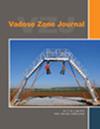土壤分层对贝尔坎入渗理论和实践影响的数值试验
IF 2.8
3区 地球科学
Q3 ENVIRONMENTAL SCIENCES
引用次数: 0
摘要
考虑到较密实但导电性较差的上层土壤覆盖在较密实但导电性较好的底土上,简单的三维(3D)入渗运行有望获得比底土更具代表性的上层土壤结果。但是,需要从数量上确定什么是更具代表性。为此,研究了零蓄水池水头(d0H0设置,d =环插入深度,H =蓄水池深度)和实际贝尔坎运行(d1H1设置,d = H = 1 cm)下的理论无约束入渗过程的数值模拟。所考虑的层状土的分层程度不同(从弱到强;下层土壤的导电性是上层土壤的2.3-32.4倍(取决于分层程度)和上层土壤的厚度(0.5 - 3cm)。当上层土壤渗透性较差时,水的入渗应该更能代表上层土壤,因为在2小时的实验中,层状土壤的瞬时入渗速率是均匀低渗透性土壤的1.0-2.1倍,比构成下层土壤的均匀粗质土壤的瞬时入渗速率小1.3-20.7倍。与均匀细土相似度随上层厚度的增加而增加。在弱分层条件下,与形成分层系统的两种均质土壤相比,分层土壤的入渗中等。分层程度较强时,层状土更接近均质细土而非均质粗土。使用实际设置而不是理论设置应该对瞬时入渗率产生小到中等的影响,因为d1H1和d0H0设置之间的所有计算百分比差异都落在−18.8%至+17.4%的相对狭窄的范围内。序列分析程序似乎可用于检测分层条件,但与最初提出的程序相比有一些修改。实际设置增强了识别底土特性开始影响入渗过程的时间的可能性。总之,本研究有助于更好地解释由导电性较差的上层土壤覆盖在导电性较高的下层土壤上的土壤中理论和实际建立的三维入渗过程,并且还表明,修改最近提出的仅使用入渗数据的顺序分析程序可能是可取的,以确定分层开始影响过程的时间。本文章由计算机程序翻译,如有差异,请以英文原文为准。
A numerical test of soil layering effects on theoretical and practical Beerkan infiltration runs
Abstract With reference to a more compacted and less conductive upper soil layer overlying a less compacted and more conductive subsoil, a simple three‐dimensional (3D) infiltration run is expected to yield more representative results of the upper layer than the subsoil. However, there is the need to quantitatively establish what is meant by more representativeness. At this aim, numerically simulated infiltration was investigated for a theoretically unconfined process under a null ponded head of water (d0H0 setup, with d = depth of ring insertion and H = ponded depth of water) and a practical Beerkan run (d1H1 setup, d = H = 1 cm). The considered layered soils differed by both the layering degree (from weak to strong; subsoil more conductive than the upper soil layer by 2.3–32.4 times, depending on the layering degree) and the thickness of the upper soil layer (0.5–3 cm). It was confirmed that water infiltration should be expected to be more representative of the upper soil layer when this layer is the less permeable since, for a 2‐h experiment, the instantaneous infiltration rates for the layered soil were 1.0–2.1 times greater than those of the homogeneous low‐permeable soil and 1.3–20.7 smaller than those of the homogeneous coarser soil that constituted the subsoil. Similarity with the homogeneous fine soil increased as expected as the upper layer became thicker. For a weak layering condition, the layered soil yielded an intermediate infiltration as compared with that of the two homogeneous soils forming the layered system. For a strong layering degree, the layered soil was more similar to the homogeneous fine soil than to the homogeneous coarse soil. Using the practical setup instead of the theoretical one should have a small to moderate effect on the instantaneous infiltration rates since all the calculated percentage differences between the d1H1 and d0H0 setups fell into the relatively narrow range of −18.8% to +17.4%. A sequential analysis procedure appeared usable to detect layering conditions but with some modifications as compared with the originally proposed procedure. The practical setup enhanced the possibility to recognize the time at which the characteristics of the subsoil start to influence the infiltration process. In conclusion, this investigation contributed to better interpret both the theoretical and the practically established 3D infiltration process in a soil composed of a less conductive upper soil layer overlying a more conductive subsoil and it also demonstrated that modifying the recently proposed sequential analysis procedure only using infiltration data could be advisable to determine the time when layering starts to influence the process.
求助全文
通过发布文献求助,成功后即可免费获取论文全文。
去求助
来源期刊

Vadose Zone Journal
环境科学-环境科学
CiteScore
5.60
自引率
7.10%
发文量
61
审稿时长
3.8 months
期刊介绍:
Vadose Zone Journal is a unique publication outlet for interdisciplinary research and assessment of the vadose zone, the portion of the Critical Zone that comprises the Earth’s critical living surface down to groundwater. It is a peer-reviewed, international journal publishing reviews, original research, and special sections across a wide range of disciplines. Vadose Zone Journal reports fundamental and applied research from disciplinary and multidisciplinary investigations, including assessment and policy analyses, of the mostly unsaturated zone between the soil surface and the groundwater table. The goal is to disseminate information to facilitate science-based decision-making and sustainable management of the vadose zone. Examples of topic areas suitable for VZJ are variably saturated fluid flow, heat and solute transport in granular and fractured media, flow processes in the capillary fringe at or near the water table, water table management, regional and global climate change impacts on the vadose zone, carbon sequestration, design and performance of waste disposal facilities, long-term stewardship of contaminated sites in the vadose zone, biogeochemical transformation processes, microbial processes in shallow and deep formations, bioremediation, and the fate and transport of radionuclides, inorganic and organic chemicals, colloids, viruses, and microorganisms. Articles in VZJ also address yet-to-be-resolved issues, such as how to quantify heterogeneity of subsurface processes and properties, and how to couple physical, chemical, and biological processes across a range of spatial scales from the molecular to the global.
 求助内容:
求助内容: 应助结果提醒方式:
应助结果提醒方式:


